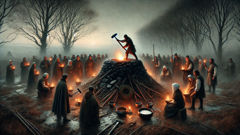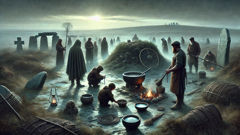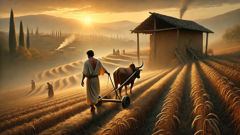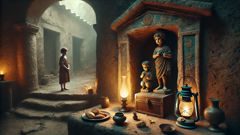Introduction
On the northerly edge of the great marshes where County Cork slopes slow and green to bog and thicket, a name was spoken in small, guarded circles: Abhartach. The syllable was never used lightly. Elders would call it out only when the hearthfire dimmed, as if the word itself might summon something that had once been and then refused to die. He was not like the tall, grave kings sung of in praise-poems; Abhartach was a chieftain of small stature, sharp in will and sharp in cruelty, a dwarf whose greed for power left scars on families and stolen harvests across a dozen townlands. His court was held beneath a low ringfort of earth and stone, where his voice—thin but iron—bent men to fear. He ordered laws by which cattle were taken, marriages delayed, and children apprenticed as if they were tools. In the telling that passed down through hearth smoke and holy water, his death came not as noble atonement but as a frantic theft. A rival slew him in secret, the ire of neighbors given a bloody answer, and his body was buried beneath a cairn. That burial began a new measure of dread. Within a week, those who had once opposed him slept poorly, woke pale and thin, and sometimes with the glint of fresh bite upon their veins. Livestock grew listless, wells tasted of iron, and people drank their milk as if it were laced with cold. The old women whispered of the ways of the otherworld; the priests muttered of rites neglected. What is told in these pages is a careful weaving of those whispers—how a grave could become a beginning instead of an end, how a king could keep his hold upon a people after earth had closed above him, and how the living finally reached for a solution that mixed the firmness of iron with the stubborn belief in charm and ritual. This retelling draws on the land—the peat and the ringfort, the hedges and the low stone bridges—and on the customs that might have birthed the tale. It is not an academic catalog of variants but a single, immersive thread meant to carry the reader through the dark mists and muddy paths of a time when names had power and hunger wore the face of a ruler.
The Chieftain's Tyranny and the First Burial
Abhartach's ascent to power had been piecemeal, needlework rather than a single bright cloth. He began, as many do, with a sharp intelligence and a sharper tongue. Born to a minor household within a ringfort of low stones, he learned early that stature mattered less than the way you used it. Where others might have offered grain or marriage to secure allies, he took and demanded; where men expected the judge to weigh mercy with law, Abhartach favored the law. As his holdings grew, so did his cruelty. The harvests of neighbors were taxed until the granaries echoed hollow. Cattle disappeared down narrow passes; children were taken for service in his hall and never sat again with their parents at feast. Rumor named him small, but it was the measure of his appetite for dominion that kept the people quiet for seasons. Tales of his appetite—both of power and, later, of blood—traveled along hedge and road like smoke.

The greater myths of the island speak of kings who died and departed; Abhartach's death would not be of that nature. A secret plot was drawn in the half-light of a winter, at a time when the peat fires were low and tempers burned hotter for lack of comfort. Men who had lost sons, women whose livestock disappeared in the night, farmers with staked fields glaring to the sky—all agreed on a plan: the chieftain must be removed. They found their chance in a quarrel over a woman of good sense, and a blade that tasted iron found Abhartach's side. He fell with a curse that tasted of prophecy. Where most would think a tyrant's final breath would close the story, the earth itself refused to take its final shape around his body. The funeral mound raised over his corpse was not enough, the stone cairn not heavy enough to seal a mind bent upon continuance. By dusk, a different sorrow crept across the settlements: a neighbor sickened without fever, the village dog lay with a mouthful of blood dried at its muzzle, and a child woke as if pricked while asleep.
At first, explanations were small and human: blame the weather, blame the season, blame an unlucky turn. But misfortune has a way of sharpening suspicion until it takes on edges of its own. An old currach man—who had once tended to the dead as he tended to the nets—called to mind an older fear. He remembered rites that were used when a corpse was thought to be bound to the earth by unnatural will: a stake driven heart-stead through chest; iron hammered into bone; a certain mix of ash and bog-moss to prevent a restless return. Such measures were whispered in fragments, often spoken with the addition of a prayer or a curse. Men smoothed stones over Abhartach's cairn and returned to their work, but the sickness did not relent. The air tasted of iron; wells once bright with trout grew stale. The old midwives said the babies were unsettled. A child's cheeks hollowed prematurely, and the mark of two teeth was seen in the crook of her elbow. Fear, slow at first, became a tight band that circled the parish.
The priests and learned men were called. Some counseled binding through holy rites, others through older customs—things touched by the otherworld and made practical for survival. It was a rift between the living practices of faith and the older folk-lore that had never quite been permitted to die. On a fog-wet night they opened the cairn with hands that trembled. The corpse lay small, as it had been in life, but the color of its hands was wrong—too fresh, as if washed in a silver stream. The men who had wielded the shovel looked upon it with a sort of coldness. One of the elder women cried out, convinced of what the children had hinted at: the Abhartach did not sleep. He had awoken hungry.
The words spread then, not with the neat certainty of law but with the lurching momentum of panic. A man in the next town reported blood sapping from his child’s wrist while she slept. Cows were found standing in the fields with their bellies scoured as if by a predator that left no tracks. That the tyrant should retain a need for blood was intolerable; that this need should be fulfilled from the living was obscene. Proposals of iron and consecration gained strength. Charms, once reserved for harvest blessings, were repurposed. The culture of the people became the toolbox for their salvation. It is here that the tale slips between fact and enchantment: some say Abhartach could rise because he had been too cunning to accept the limits of death. Others argued his heart was not whole; that the burial itself had been bungled; that a trick of the grave had let his will seep like water back into the world.
Arguments notwithstanding, one certainty governed the nights: the living had to be defended. A choice was made to fashion a stake not of a tree but of iron—black, heavy, hammered by the smith whose hands had once crafted plowshares. Iron held the earth's memory and the memory of war; it was thought to have the power to pin will to soil. The smith's son would later recite how they heated the iron until the smell of sweat and peat and iron mingled, how the stake sang as it cooled. They returned at dusk to Abhartach's cairn, carrying the stake, a bowl of salt, a bundle of holly, and a chant half in Latin and half in the old tongue. The pounding of the stake, when it came, was not swift. It was a ritual performed with the careful cruelty of those who must kill twice: once with blade, again with custom. When the iron bit bone and closed around the rib, the earth seemed to sigh. The story says the body writhed and that its voice was like dry leaves. Then, finally, the mound settled into a ordinary silence. For nights after, the people watched the horizon for a return. Sometimes, out on the bog, a light would be seen—a small glimmer that could be a will-o'-the-wisp, or the eye of something that had learned to wait. But the immediate hunger eased. Whether the stake was the true end or simply the first answer that bought a village its breath, the tale persisted and grew in telling, deepening the contours of fear and the means by which people resist what they cannot understand.
Gravebound Hunger and the Quest for Peace
Even after the iron was set and the cairn closed, the story of the Abhartach lived both in the bodies of those who remembered and in the land itself. Memory is tenacious in places where life and death meet on a daily basis; peat keeps its secrets as tightly as the earth holds bones, and the people who worked that ground could feel a shift in the seasons. The Abhartach story became a way to explain small tragedies and to impose a measure of order on randomness. When a child was found pale and unaccounted for, the tale supplied a villain and a ritual response. When a man returned from the sea with his eyes hollowed by drowning or by sorrow, the narrative of the king's curse offered a language for grief. This is one reason folklore persists: it is not merely entertainment but a map for living under the weight of misfortune.

There were, however, practical consequences that the tale could not excuse. A hill where a tyrant had once been buried changed usage; no one planted crops too close. New rites were adopted. If someone died under suspicious circumstances, the body was treated not as an ending but as a potential continuation. Salt and bog-moss were more often placed with the dead; a piece of iron might be left upon the chest; the placement of the body was considered with a caution that had not been customary before. Priests and charm-workers argued but also learned from one another. The liturgy adopted, in pockets, a few of the older precautions: certain prayers were said at funerals that had been forgotten, and certain songs were sung to make the borders between the living and the dead more obvious and strong. Meanwhile, the old women of the town—the bearers of kitchen lore and bitter remedies—kept watch over infants whose hands trembled in sleep and performed small rites in secret, using thread and thorns to stitch a child's dream back into safety.
Not every telling of Abhartach's return involves the same details. In some villages he was truly monstrous: a figure who rose each night and drank from the living as one drinks from a cup. In others, the emphasis is on the social horror: that a man who had abused power could bind his malice to the land and continue to make life miserable for ordinary folk. Where the story grew teeth was in its ability to combine both fears—literal blood-drinking and the metaphorical sucking of life from communities under unfair rule. That duality made the figure of Abhartach useful to bards and preachers alike: it was a cautionary figure for chieftains and a validation of the cunning measures taken by the weak to protect themselves.
Generations later, as the island changed with new kings and later, new laws, the Abhartach persisted in the tale-lore precisely because rituals adapted to new circumstances. Iron turned from a stake to a symbol—iron gates, iron nails over thresholds—while the chants shifted to include saints invoked for protection. Even so, when famine came or disease spread, villagers would sometimes be heard reciting the old words, half prayer and half curse, in case the boundaries had thinned. There was a hum of a communal memory that vibrations along the hedgerows; people could not erase their fear because it had been proven true often enough to justify caution.
There are episodes where the legend shifts into a different register of belief: the notion that Abhartach had bargains with the otherworld. Folk magic in Ireland is generous with exchange—leave a trinket for the fair folk and they will leave you peace—and so in some versions the chieftain had bartered away his rest for power in life. After he died, the bargain still bound him; he had to feed. These versions are darker and more complicated, because they posit a world where moral order is not enough: you must also be adept at the mechanics of exchange with forces that do not play by human rules. A family might leave milk at the edge of the bog to placate a hunger they could not name; a shepherd might keep a charm of iron near his breast. These acts, small and ritualized, knitted the social fabric back together, offering people a sense of agency.
The Abhartach narrative also touches on justice and accountability. If a ruler could persist in inflicting suffering after death, what of those who had let him rule? The stories tilt between condemnation and empathy. Some narrators ask whether the rise of a tyrant is simply a failure of the people to act sooner. Other tellers point to the complexity of living under threats and pressures, and the terrible bargains communities make to survive. Over time, the character of Abhartach became a moral instrument: a dramatized example of the consequences of cruelty, and an instructive tale for those who wield power. It warned not only of what happens when a tyrant is not properly buried but of what happens when a people accept small tyrannies for the sake of quiet.
The most enduring images of the tale are the tactile ones: the iron stake hot from the forge, the smell of peat smoke and wet wool, the cold press of night air over the bog, and the sound of a hammer that rings long after the hands that held it are gone. These sensory recollections are what keep the legend alive in oral culture. When modern ear hears the name Abhartach, it brings with it the sense of a place where the line between the living and the dead was thinner, where power could cling and where ordinary people had to invent customs to survive. Folklorists have traced echoes of the Abhartach into other stories of revenants across Ireland and Britain, noting similar uses of iron, staked graves, and salt as protective agents. Whether the original was a literal blood-drinking corpse or a vivid metaphor for oppressive rule, the steps taken by the living—rituals, charms, and cooperation—are the real heart of the story. In that sense, Abhartach remains less an isolated monster than a mirror held up to communities deciding to keep one another safe through known rites and shared vigilance.
Conclusion
Legends survive because they do work for the people who tell them: they explain, they warn, and they give rituals through which communities can act. The Abhartach is all these things. He is the story of a tiny chieftain whose cruelty was so large that it seemed to outlast death itself, and he is, at the same time, a narrative resource that taught villages how to protect their own. The rituals—iron hammered into earth, salt sprinkled in corners, charms woven with thorns—are not mere superstitions but social technologies born of necessity. They married craft and belief, the smith’s practicality with the old women’s lore, the priest’s words with folk practice. In a landscape where bog and ringfort still keep the bones of many forgotten lives, the tale of Abhartach persists as a way to talk about power, accountability, and the measures people will take to reclaim safety. To tell the story is to remember that the boundary between living and dead was once treated as porous; to retell it now is to consider what we do with power that refuses to pass. The old mound remains a mound, the iron a relic, the songs a thread that ties present to past. When the wind moves across a peat bog and the moon slices through reeds, you might still hear a faint echo—a hammering sound, the hush of a vigil—reminders that some stories endure because they keep us alert, and because they teach us how to act when the things we fear return in one form or another.













